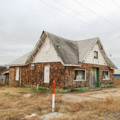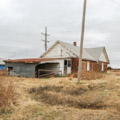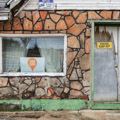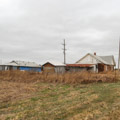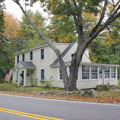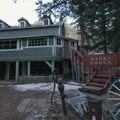“I wake up every morning in a house that was built by slaves.”[1] In her 2016 speech at the Democratic National Convention, Michelle Obama deployed this documented fact about the construction of the White House (begun 1792) as a rhetorical flourish to emphasize her belief in the progress and potential of the United States. When the line went viral, predictably, it became fodder for pundits, but it also offered a profound civics lesson for anyone who considered the full import of the First Lady’s words. She was not only acknowledging the contributions of enslaved laborers and craftsmen to this particular building-cum-icon, she was also prompting us, as Americans, to accept our responsibilities, as citizens, to rewrite our foundational myths and retell our national epics. While this requires us to be brutally honest about our country’s collective past, it also affords us the opportunity, as bell hooks would have it, to make visible in our collective memory centuries of erased experiences and “subjugated knowledges.”[2] The hard work of remembering is not only in the service of truth-telling; more powerfully, this work resists—and hopefully even helps to dismantle—those dominant structures of white supremacy, heteropatriarchy, and class-based exploitation that we have allowed to remain in place in this country for far too long.
Some historians, in this third decade of the twenty-first century, might dispute the necessity of such schooling, arguing that contemporary practitioners of the discipline have been revising the canon, in one form or another, for several decades, broadening history’s subjects, expanding its perspectives, and diversifying its voices—with a goal of moving beyond a history predicated on “dead white European males” or DWEMs, to use the 90s acronym. Only the most reactionary among us would question the necessity and importance of this inclusionary work, but, as Ibram X. Kendi has argued, not being racist is not enough.[3] The work must be explicitly anti-racist: it must actively critique and challenge the historiographies and methodologies that have reified systemic oppression and biased hierarchies within the project of history itself, all fully evident in its institutions, its publications, and its narratives.
For architectural historians, this reckoning is complicated by a long arc of incremental revisionism that gained strength in the final decades of the twentieth century when it even included something as fundamental as disciplinary nomenclature. Take Nikolaus Pevsner’s oft-quoted opening sentence of his 1943 Outline of European Architecture: “A bicycle shed is a building; Lincoln Cathedral is a piece of architecture.”[4] Here, whether Pevsner was articulating a binary or a dichotomy, his distinction between mere building and capital A architecture was undeniably problematic, and it had long-standing interpretive consequences relative to the values ascribed to a diverse range of built work, and, as a result, their worthiness as subjects of scholarly inquiry. Indeed, Pevsner’s distinction was potent enough that nearly half a century later, one of his most important students called it out as more than just “academic snobbery.” Pevsner’s argument, Reyner Banham contended, was founded upon “a supposition about sheds that is so sweeping as to be almost racist.”[5]
When Banham, who, like Pevsner was white, wrote those words in 1988 (the year he died), his reputation as a provocateur was as well-established as his standing as a scholar. In his essay “The Black Box,” which is mostly about the inscrutability of architectural communication and domains of professional expertise, Banham’s invocation of race was largely figurative. It reads as a literary device, seemingly a throwaway line intended to telegraph his supposed street cred to “new intelligentsia” readers of the New Statesman and Society, the journal of cultural critique in which Banham had published much of his freelance journalism, and where his essay appeared posthumously in 1990. Four decades on, however, Banham’s racialized refutation of Pevsner offers two valuable reminders to contemporary architectural historians, and to contemporary readers of the histories we write.
First, we must pay attention to the tropes and flourishes deployed in the service of criticism and history. Was it reasonable or appropriate for Banham to use race to embellish an argument about assessments of built form? Despite the continued value of his scholarship, it is frequently marred by ham-fisted and baldly glib remarks that not only touch upon race, but that smack of sexism, gender-bias, and even speciesism—even as he was consistently well-attuned to the ways that elitism and class shaped perception and production of architecture and design. Noting the problematic dimensions of Banham’s work is not much ado about nothing, nor is it oversensitivity to the discourse of an older generation. Thanks to the pioneering research of historians like Irene Cheng, Charles Davis, Mabel Wilson, and others, we understand that whether they did so knowingly or inadvertently, historians like Banham and Pevsner were building on and responding to nineteenth-century architectural theory with origins in pseudo-scientific racial classification schemes.[6] Taking seriously the project of what is frequently and problematically called "decolonizing" means recognizing semantic consequences: even offhand comments, like Banham’s about sheds, contribute to knowledge formation.[7]
Second, even as we critique the way Banham critiqued Pevsner, we should take to heart the point he was making about typologies and hierarchies in built form. Banham never sought to expand the architectural canon—even though, inevitably, much of his scholarly work was pressed into such service. Rather, Banham was enjoining us to avoid the trap of evaluating buildings using irrelevant standards (i.e., those derived exclusively from the modes of design that have come “to occupy a position of cultural privilege in relation to the construction industry”) and to, instead, take them on their own terms regardless of the interpretive consequences.[8]
His insights remind us that the project of history should always be expansive. Indeed, throughout his career, Banham worked to expand Pevsner’s far more narrow approach to architecture’s histories. He proposed a plurality of modernisms to replace the singularity of the William Morris-to-Walter Gropius evolutionary genealogy that Pevsner articulated in Pioneers of Modern Design. He applied to everyday and commercial buildings the documentary and interpretive seriousness that characterized the churches-and-castles approach of Pevsner’s Buildings of England. Banham studied daylight factories and grain elevators not simply in relation to their influence on European modern architecture, but as separate and significant achievements of industrial building. He also helped instigate the study of Los Angeles as a new kind of horizontal city, one that challenged conventional notions of density and urbanism and geo-cultural dominance.[9]
Banham’s trajectory in each of these areas was not unique, but he was certainly in the vanguard of examining the fullness and variety of built form wherever he encountered it and of sharing his work as broadly as possible, not only with scholars, students, and professionals, but also with a popular audience. Though Banham may have mostly failed to acknowledge the white Eurocentric cultural assumptions and social prejudices that informed his scholarship, he was able to recognize that his readers always bring their own critical perspectives to his work, especially those of a younger generation. Even before he died, these readers were already questioning, for example, his embrace of techno-optimism and consumer capitalism and his apparent disregard for environmentalism and the causes of civil unrest. Rather than reject these critiques out-of-hand, Banham—ever the historian—sought to situate his scholarly projects within his zeitgeist, i.e., the precise socio-cultural contexts in which he was working. This, he hoped, would clarify his historiographic intentions relative to “the state of architecture culture and its value systems” at the time he was writing.[10] It would be easy to dismiss this as an apologist’s lament; but let’s embrace it as a futurist’s challenge.
In 2022, we should hold ourselves to the same standards, and insist that one, two, three, four, or five decades hence, our readers consider how well we wrote architecture’s history relative to this moment now—when our culture and values will no longer tolerate us telling anything except the fullest possible stories about the past and present of our buildings and places. Gathered here are a series of essays that that help us begin this work. These include histories of architects, developers, organizers, activists, businesspeople, and everyday folks who identified as LatinX, LGBTQ, African American, Native American, and as members of the Asian diaspora, all of them shaping neighborhoods, districts, cultural landscapes, and individual structures. As a web-based publication with nearly 30,000 online essays and entries, SAH Archipedia has long contained content that reflects our built environment’s “dynamic heterogeneity” and “dynamic diversity,” as the founding editors of the Buildings of the United States put it back in 1993. (This is the book series out of which SAH Archipedia grew.)[11] Because this content most fully embraces typological and geographic heterogeneity, we turn now to focusing on histories of built form that embrace diversity from across all of our socio-economic, socio-cultural, ethnic, and racial communities. We have been fortunate that so many talented and dedicated historians have already contributed to this inclusionary project.
And still, in 2022, it is important to declare that we are beginning this work. Aware of the project’s enormity, we turn to James Baldwin: “Responsibility cannot be lost, it can only be abdicated. If one refuses abdication, one begins again.” Aware of the project’s possibility, we turn to Tony Kushner: “The world only spins forward. We will be citizens. The time has come…The Great Work Begins.”[12]
Publication of this essay and the entries in this series was made possible by the generosity of the Graham Foundation for Advanced Studies in the Fine Arts.
[1] Michelle Obama, Speech at the Democratic National Convention, July 25, 2016. PBS
News Hour. https://www.youtube.com/watch?v=4ZNWYqDU948.
[2] bell hooks, “Black Vernacular: Architecture as Cultural Practice,” Art on My Mind (New York:
New Press, 1995) 151.
[3] Ibram X. Kendi, How to Be an Anti-Racist (New York: One World, 2019).
[4] Nikolaus Pevsner, Outline of European Architecture (London: Pelican Books, 1943) 21.
[5] Reyner Banham, “The Black Box,” New Statesman and Society, October 12, 1990, 23.
[6] See, for example, Irene Cheng, Charles Davis II, Mabel O. Wilson, eds. Race and Modern Architecture: A Critical History from the Enlightenment to the Present (Pittsburgh: University of Pittsburgh Press, 2020).
[7] In the ten years that have passed since Eve Tuck and K. Wayne Yang asserted that "decolonization is not a metaphor," the term has gained currency, for better or worse, as shorthand for the project of dismantling the hierarchies of power not only in specific colonial/settler and subaltern/Indigenous contexts but in cultural discourse more generally, wherever the dynamics of unequality make themselves visible. See Eve Tuck and K. Wayne Yang, "Decolonization is Not a Metaphor," Decolonization: Indigeneity, Education & Society 1 (September 2008): 1–40.
[8] Banham, “The Black Box,” 23.
[9] See Reyner Banham, Theory and Design in the First Machine Age (1960; Reprint, Cambridge: MIT Press, 1980); Banham, Los Angeles: Architecture of Four Ecologies. (New York: Harper and Row, 1971). See also Nikolaus Pevsner, Pioneers of Modern Design (London: Faber and Farber, 1936); Pevsner, Buildings of England, multiple volumes (London: Penguin Books, beginning 1951).
[10] Reyner Banham, The Architecture of the Well-Tempered Environment (1969; 2nd edition. Chicago: University of Chicago Press, 1984): 13. See also Barbara Penner, “The Man Who Wrote Too Well,” Places (September 2015). Accessed March 7, 2022. https://doi.org/10.22269/150908.
[11] Adolf Placzek, William H. Pierson, Osmond Overby, “Foreword” in Pamela Scott and Antoinette J. Lee, Buildings of the District of Columbia (New York: Oxford University Press, 1993), v-vi.
[12] James Baldwin, Just Above My Head (New York: Dial Press, 1979), 366. Tony Kushner, Angels in America, Part Two: Perestroika (1991; Revised, New York: Theater Communications Group, 1995) 280.
Writing Credits
If SAH Archipedia has been useful to you, please consider supporting it.
SAH Archipedia tells the story of the United States through its buildings, landscapes, and cities. This freely available resource empowers the public with authoritative knowledge that deepens their understanding and appreciation of the built environment. But the Society of Architectural Historians, which created SAH Archipedia with University of Virginia Press, needs your support to maintain the high-caliber research, writing, photography, cartography, editing, design, and programming that make SAH Archipedia a trusted online resource available to all who value the history of place, heritage tourism, and learning.

